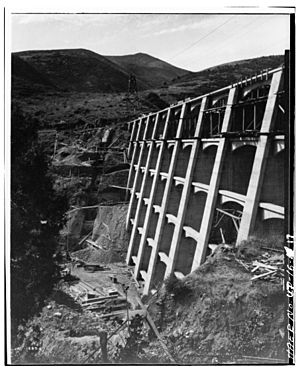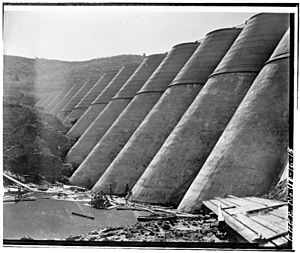Mountain Dell Dam facts for kids
The Mountain Dell Dam is a very important structure that helps provide water for Salt Lake City, Utah. It's located about 10 miles (16 km) east of the city, in Salt Lake County, near Interstate 80 in Parley's Canyon. This dam creates a large reservoir that stores and helps manage water for the city.
The dam was designed by John S. Eastwood and built between 1914 and 1925. It's a special kind of dam because it combines two different building styles: a buttress dam and a multiple arch dam. When the city first planned the dam, they really needed more water, especially during dry summers and cold winters.
Once the dam was finished, Salt Lake City had a much bigger water supply. It could store 850 million US gallons (3,200,000 m3) of water and distribute 24 million US gallons (91,000 m3) each day. Before the dam, they could only distribute 9 million US gallons (34,000 m3).
The Mountain Dell Dam was added to the National Register of Historic Places in 1980. This means it's recognized as an important historical site.
How the Dam Was Designed
When they were planning the Mountain Dell Dam, engineers looked at three main types of dam designs:
- A solid, arched dam (gravity type).
- A reinforced concrete dam like the Ambursen design.
- A multiple arch reinforced concrete dam, which was Eastwood's idea.
After thinking it over, they chose the multiple arch design. One big reason for this choice was the ground, or bedrock, at the building site. The bedrock was a type of limestone shale that wasn't completely waterproof. It could also break down a bit when exposed to air and water.
The multiple arch design was a good fit because it helped prevent water pressure from pushing up on the dam. It also made it very hard for the dam to tip over or slide. Plus, this design made it easy to check the inside of the dam for any problems.
Building the Dam
The Mountain Dell Dam was built in two main stages. The first part was finished in 1917, reaching a height of 105 feet (32 m) above its foundation. The second part was completed in 1925, adding another 40 feet (12 m) to the dam's height.
Building the dam cost more than expected because they had to dig very deep, 43 feet (13 m) below the ground in the canyon, to find strong bedrock for the foundation. The spillway (where extra water flows out) is 4 feet (1.2 m) below the top of the dam. This means the deepest part of the reservoir is 58 feet (18 m) up to the spillway's top.
The dam has 11 large supports called buttresses and 11 arches from the first stage. Five more buttresses and five more arches were added in the second stage. At its widest point, the dam is 132 feet (40 m) thick from the front of an arch to the back of a buttress. The buttresses are 8 feet (2.4 m) thick, and the arch rings are 4.1 feet (1.2 m) thick. At the very top, the dam is 15 inches (380 mm) thick. The arches are shaped like parts of a circle, covering 120 degrees. Each buttress is 35 feet (11 m) apart from the next.
The dam has two sets of gates to let water out. Each set has two 24 inch (610 mm) pipes with a screen at the entrance. Each pipe also has a butterfly valve and a double-disc gate valve to control the water flow.
In total, 8,271 cubic yards (6,323 m³) of concrete were used to build the dam. The whole project cost $90,000. The dam can now hold a bit more than 300 million US gallons (1,100,000 m3) of water. The overall design and building process were overseen by Sylvester Q. Cannon, who was the City Engineer of Salt Lake City, with John S. Eastwood as a special consultant. The company that built it was Parrott Bros. Co..
Current Condition
As of 2019, the Mountain Dell Dam was listed as being in "poor" condition. This means it needed repairs. Because it's close to highways and parks, any problems with the dam could be risky. To fix it, a special lining is being put on the upstream side (the side facing the water). This lining will help stop water from getting into the dam's structure, which can cause damage from freezing and thawing. Until these repairs are finished, the reservoir might only be kept half full during the winter months to prevent further damage.




